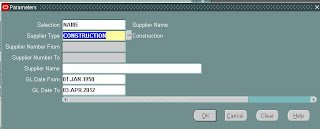Requirement - Business need is to have multiple parameters but end user will be allowed to use one at a time. selection of any parameter, should disable others.
Solution - Below is one possible option which provides the same behavior in other way.
Solution - Below is one possible option which provides the same behavior in other way.
This requires one additional parameter as Selection/Choice which will decide the enabled parameter.
There will be as many dummy (non displayed) parameters as required parameters in program. actual parameters will be dependent on respective dummy parameters.
Dummy parameters will be dependent on selection parameters and hold values based on selection.
Example - User requires 2 parameters supplier number and name to be available on one report and only one should be selected at time. So the requirement was to make other disable. dependent parameters has limitations and it cannot flow bottom to top. we can achieve this by introducing one selection parameter, which can hold 2 values -
1) Name – Supplier Name
2) Number – Supplier Number
Initially both Supplier Number and Name range parameter will be disabled.
Selection = Name , will enable supplier Name parameter range.
Selection = Number , will enable supplier Number parameter range.
Implementation – Create 3 dummy parameter (1 displayable and 2 non displayable).
Parameter | Value Set | Enable | Display |
Test1 | VS0 | Y | Y |
Test2 | VS1 | Y | N |
Test3 | VS2 | Y | N |
Value Set - VS0, will hold below values
Parameter Test2 and Test3 :
Default Value select decode(:$FLEX$.VS0,'NUMBER','Y',NULL) from dual
Test3 will have similar definition.
Value Set = VS2
Default Value select decode(:$FLEX$.VS0,'NAME','Y',NULL) from dual
Now include the below condition for Number and Supplier Value set definition –
Supplier Number Value set - :$FLEX$.VS1='Y'
Supplier Name Value set - :$FLEX$.VS2='Y'










